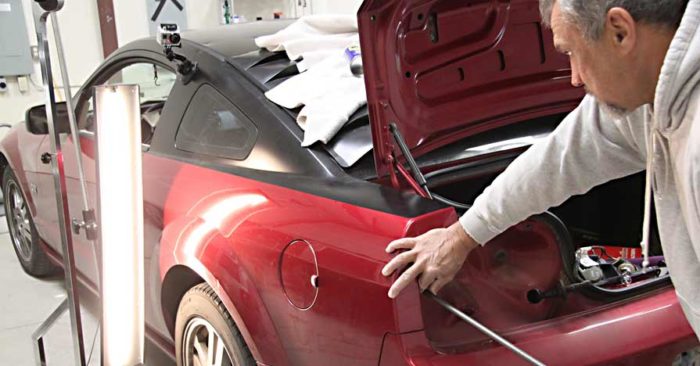Have you ever returned to your car after a shopping trip only to discover that someone dented your car? Or you accidentally backed into a post and left a nasty dent in your car. Whatever the case, dents are a common problem for car owners. Fortunately, there are two popular solutions for dent removal and auto dent repair: paintless dent repair and traditional dent repair. In this article, we’ll explore the differences between these two methods and help you determine which is right.
Paintless Dent Repair: A Non-Invasive Solution
Paintless dent repair, or PDR, is popular for removing minor dents from cars. This technique involves massaging the dented area of the car with specialized tools until the metal is returned to its original shape. Unlike traditional dent repair, PDR requires no painting or body filler. This means that your car will retain its original finish and value.
When Is PDR Appropriate?
A paintless dent repair is a good option for minor dents, such as those caused by hail, door dings, and minor collisions. PDR is also appropriate for dents that have not caused any damage to the paint. If the paint on your car has been damaged, PDR may not be appropriate since the metal may need to be reshaped beyond its original form.
The Advantages of PDR
One of the biggest advantages of PDR is that it is a non-invasive solution. This means that there is no need to replace any panels or apply any auto body filler. PDR is often a quicker solution than traditional dent repair, which means you can get back on the road sooner.
The Process of PDR
Paintless dent repair is a specialized technique that requires skill and experience. The process begins by assessing the dent and determining if PDR is appropriate. If so, the technician will use specialized tools to massage the metal from behind the dent until it returns to its original shape. This technique requires patience and precision to ensure that the metal is reshaped without causing any damage to the surrounding area.
Traditional Dent Repair: A Tried and True Method
Traditional dent repair involves filling the dented area with auto body filler and sanding it down until the surface is smooth. Once the surface is smooth, a coat of paint is applied to match the color of your car. This method is often used for larger dents or dents that have caused damage to the paint.
When Is Traditional Dent Repair Appropriate?
Traditional dent repair is appropriate for larger dents that cannot be repaired through PDR. Additionally, traditional dent repair is a good option if the paint on your car has been damaged. This method allows for the damaged paint to be repaired and for the car to be repainted to match the original color.
The Advantages of Traditional Dent Repair
One of the biggest advantages of traditional dent repair is that it can be used to repair larger dents that cannot be repaired through PDR. Additionally, traditional dent repair allows for damaged paint to be repaired and for the car to be repainted to match the original color.
The Process of Traditional Dent Repair
Traditional dent repair involves a different process. The first step is to assess the damage and determine the extent of the repair needed. If the dent is large or has caused damage to the paint, the technician will use auto body filler to fill in the damaged area. Once the filler has been applied, it will be sanded down until the surface is smooth. Finally, a coat of paint is applied to match the car’s color.
Which One is Right for You?
Determining which method is right for you will depend on the size and location of the dent as well as the condition of the paint on your car. If the dent is minor and has not caused any damage to the paint, PDR may be the best option. However, if the dent is larger or has caused damage to the paint, traditional dent repair may be the better solution.
Cost Considerations
Another factor to consider when choosing between PDR and traditional dent repair is cost. PDR is often less expensive than traditional dent repair since it requires less labor and materials. However, the cost will ultimately depend on the size and location of the dent as well as the condition of the paint on your car.
Conclusion
When it comes to auto dent repair, there is no one-size-fits-all solution. Choosing between PDR and traditional dent repair will depend on the size and location of the dent as well as the condition of the paint on your car. PDR is a great solution for minor dents that have not caused any damage to the paint. However, traditional dent removal may be necessary for larger dents or dents that have caused damage to the paint. Additionally, the cost of each method will depend on the size and location of the dent as well as the condition of the paint on your car.
If you’re considering repairing minor dents independently, consider purchasing a high-quality PDR or traditional dent repair kit from a trusted seller. Ready to repair your car’s minor dents on your own? Check out our selection of high-quality PDR and traditional dent repair kits today!








